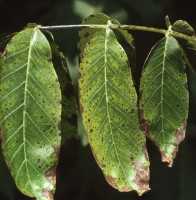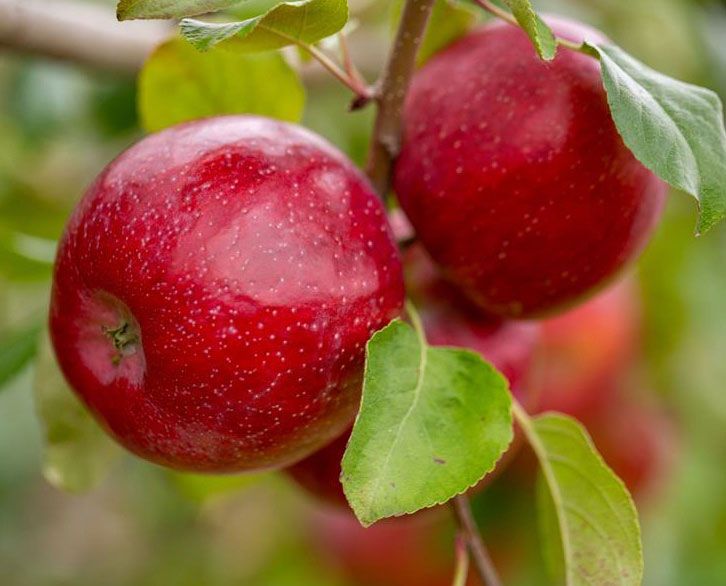Watch Your Salt Intake With Walnuts

We have seen increasing problems in northern California with salt issues in walnut orchards in recent years as water has become less available — at least until the huge snowfalls in the Sierra Nevada this past winter. Walnuts are known to be fairly sensitive to salt, and both yield and quality can be adversely affected if salt levels are too high.
Before planting walnuts, it is a good idea to evaluate the salt level in both the soil and the water. If the salinity of your soil is less than 1.5 dS/m (deciSiemens per meter) and that of your irrigation water is less than 1.1 dS/m, salts should not limit walnut production. However, for every 1 dS/m increase in soil salinity over 1.5 dS/m, you can expect about a 20% reduction in growth and presumably production potential.
| Table 1: Salt Levels In October Leaf Samples | |||
| Rootstock | Boron (ppm) | Chloride (%) | Sodium (ppm) |
| Black walnut | 480 b | 0.7 c | 56 b |
| Paradox | 667 a | 1.8 b | 87 b |
| English walnut | 704 a | 2.1 a | 125 a |
| Means followed by the same letter in the column are not significantly different from each other. | |||
Signs of excess salinity are reduced shoot growth and nut size, an increase in sunburn and kernel shrivel, and apparent water stress when the soil seems like it should have sufficient water. You may or may not see burning on the tips and along the edges of the leaves. If you suspect that you may have a salt problem, collect a leaf sample in July and send it to the lab for a salt analysis.
It’s Elementary
In addition to the total salt load, there are some specific elements/ions that can accumulate in the soil and cause problems when levels get too high — typically chloride (Cl), boron (B), and sodium (Na). They accumulate in the woody tissues and eventually move into the leaves, causing an obvious marginal burn in the older leaves and sometimes shoot death in extreme situations. Toxic accumulations of these elements can reduce the production of plant hormones and contribute to nutrient disorders.
One way to keep salinity in check is with careful irrigation management. Make sure you apply enough good quality water to equal that lost by the tree’s evapotranspiration (ET) over the course of the season, plus about 15% more to leach any salts below the root zone. Your local University of California Cooperative Extension farm advisor should be able to give you an ET chart for walnuts that is appropriate for your climate.
Another way to reduce the likelihood of salinity problems is to plant on a rootstock that is more tolerant to salt. I had the opportunity several years ago to evaluate the relative salt tolerance of seedling Black, Paradox, and English walnut rootstocks in a young Chandler orchard. This orchard had been planted with the three rootstocks arranged consecutively down the row. In the fourth year, signs of salt burn showed up on the older foliage after a change in the irrigation water source, which included some poor-quality well water.
| Table 2: Salt Levels In July Leaf Samples The Following Year | ||
| Rootstock | Boron (ppm) | Chloride (%) |
| Black walnut | 200 c | 0.2 c |
| Paradox | 326 b | 0.5 b |
| English Walnut | 368 a | 0.7 a |
| Excess level (July) | 300 | 0.3 |
| Means followed by the same letter in the column are not significantly different from each other. | ||
Sample Leaves In Fall
Comparative leaf samples were collected in October when salt concentrations would have been at their highest. The leaf tissue levels corresponded closely to visual symptoms. The trees on English walnut rootstock had the most foliar injury, and also had the highest concentration of all three toxic ions (B, Cl, and Na) in the leaf tissue (Table 1). The trees on the Black walnut rootstock were least symptomatic and had the lowest accumulation of toxic ions. The trees on the hybrid Paradox rootstock had intermediate symptoms and tissue levels.
The following season, irrigation resumed using primarily high-quality surface water with a minimal amount of poor quality well water blended in as needed. Leaf samples collected from the same trees at the typical sampling time in July showed the Black walnut rootstock to be below the excess levels for both boron and chloride (Table 2). It often takes more than one season to correct a salt excess and this was the case with both the English and Paradox rootstocks. They had accumulated more salt initially, and it took them longer to eliminate it. Both had lower levels but were still in the excess range the following July with the English again having significantly higher levels than the Paradox.
In conclusion, if you are planning a new walnut orchard and are concerned about salt issues, it may be worthwhile to consider planting on Black walnut rootstock.









